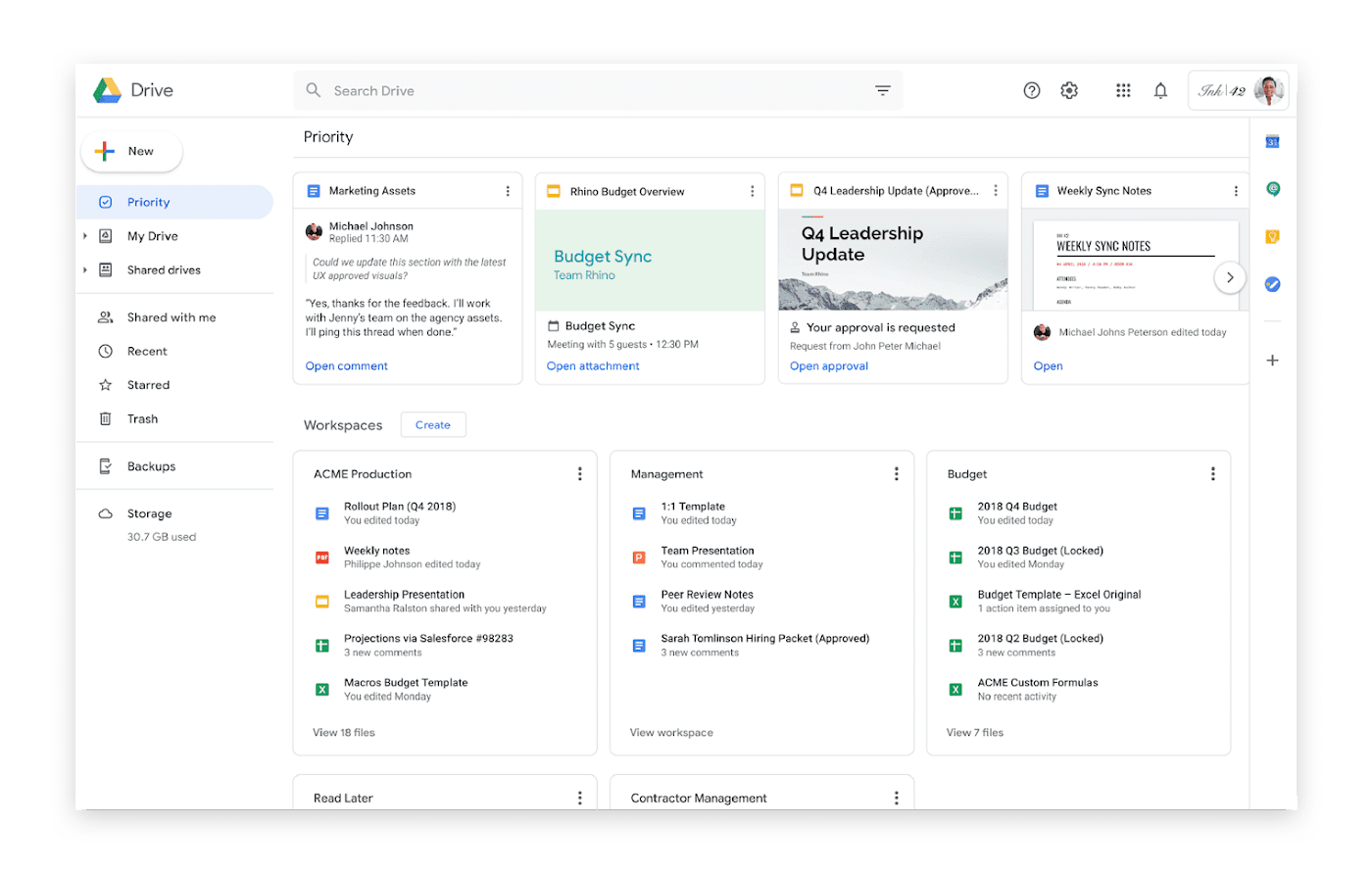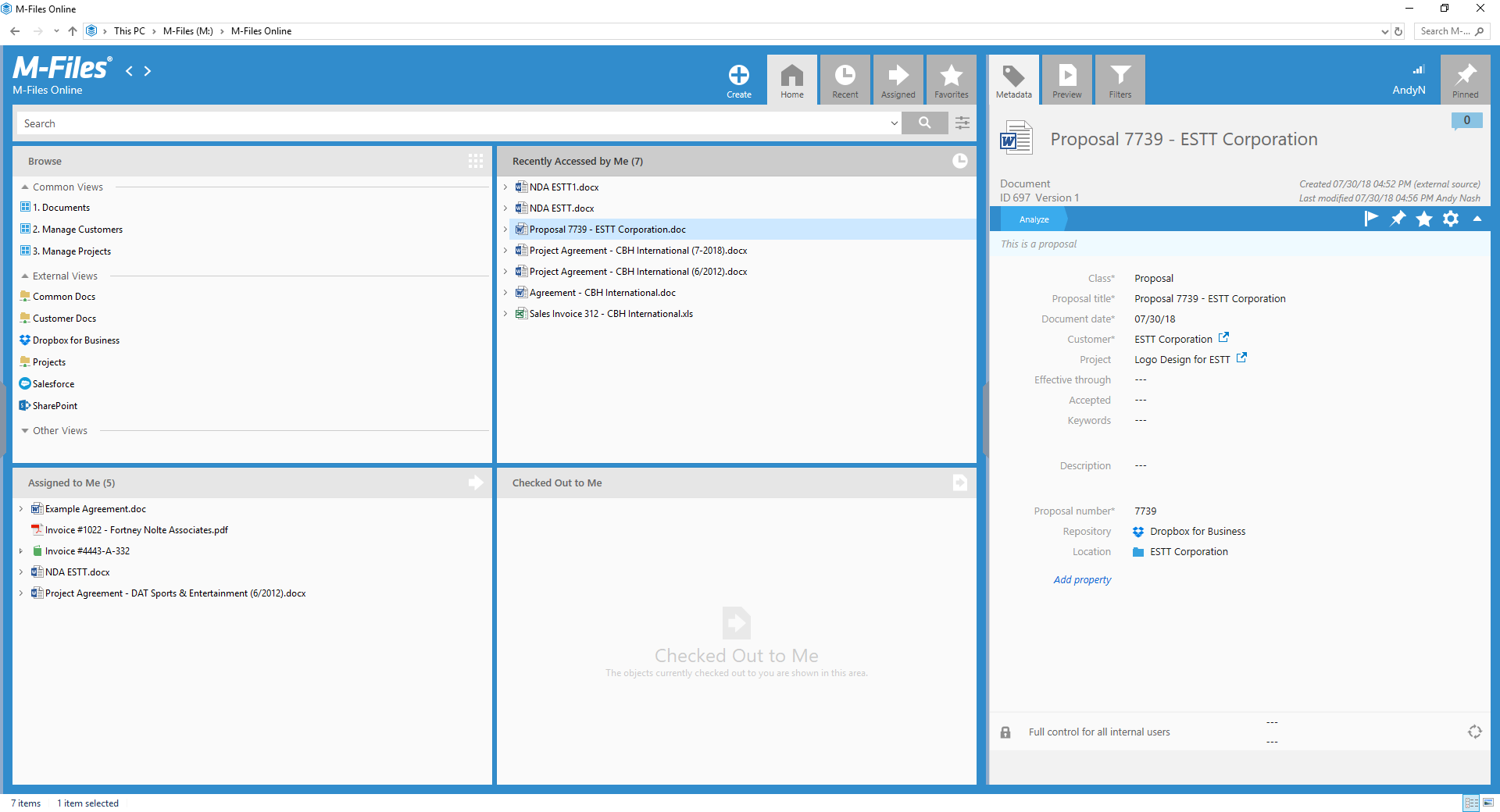
The dream of the paperless office was born in the 70s with the birth of the personal computer. It may be closer to realization now, but the digital workspace hasn’t necessarily made it easier to find the right information.
To maximize efficiency, you need more than just ordinary search functionality. A digital system can still be inefficient, as many employees store information in a way that is difficult to access or overlook.
According to a 2016 study, 38% of respondents stored data on a local hard drive and 27% on a USB drive. With information trapped in different silos, document collaboration turns into a time-sucking challenge — not to mention the risk of data loss.

(Source)
55% feel like they don’t have access to the necessary information for doing their job, as shown by a study by Nintex, with 49% of respondents having issues locating the right documents.
Under these conditions, it is no wonder that companies can’t maximize the use of their knowledge.

(Source)
But there are solutions — a document management system can help your team to work better by providing a solid foundation. Let’s start from the beginning:
What is Document Management Software?
Document management systems (DMS) use computer systems or software to organize and store the electronic documents that you capture, in a convenient, centralized location.
You can expect different features depending on which DMS you choose, but they all tend to have five essential components:
- Information capture by scanning documents
- Document storage and archiving in a logical manner
- Search capabilities and indexing to be able to locate documents easily
- Distribution methods for sharing, exporting and collaborating on documents
- Security functions to protect your documents from unwanted access
DMS is sometimes used interchangeably with Electronic Documents Management System (EDMS) and Content Management System (CMS), but they aren’t identical.
A DMS focuses on capturing and storing structured documents. On the other hand, a CMS can handle both structured and unstructured data, including web pages, images, and records.
When comparing a DMS and an EDMS, the EDMS tends to have integrated, enhanced capabilities for organizing information, distributing content, and managing workflow.
5 Benefits of Document Management Software
Your business can benefit from DMS in many ways, but five main benefits can have a massive impact on your business’ bottom line:
- Improve the time/cost efficiency with better document organization. Not only are you spared the frustration of trying to track down the information you need to do your job, but the ability to find what you need when you need it helps increase productivity.
- Streamline workflows with an integrated document management system. Commenting on a colleague’s draft, approving travel expenses, or electronically signing a new contract are examples of tasks that become easier to remember and to do.
- Aid business continuity and recovery if disaster strikes. With information stored in the cloud instead of on a USB drive, your business is less vulnerable to events such as fire, theft, natural catastrophes, or pandemics.
- Improve regulatory compliance to avoid fines or even criminal liability by ensuring that your information management follows security and privacy guidelines. A DMS tool can also help you create and maintain policies and regulatory applications.
- Increase security for sensitive information by storing files securely. A DMS system also allows you to manage document access and control the information flow by seeing who has viewed the document.
So, which is the best document management system for your business?
11 Best Document Management Solutions
We reviewed the best document management software and tools, so you don’t have to. Let’s take a look at the most popular options and what businesses they suit:
Helpjuice
Best for: Teams of all sizes use Helpjuice to create, store, and share documents, but it goes beyond just document management. Want to know what really sets the tool apart? We could say the advanced search function, complete customization, or useful reporting features…

...but, the winner has to be the access levels. Helpjuice makes it easy to manage all your company information — externally as well as internally.
Setting up a fully searchable FAQ site for customers, onboarding new employees, or collaborating on the latest sales report? Just manage the different access levels, from one single portal.
Highlights:
- Manage access levels — share information online, internally, through a URL link, or make it “invitation-only”
- Secure, quick document sharing and collaboration through the intuitive, attractive interface
- Find the right information quickly with powerful, Google-like search
- Track changes to quickly see the latest revisions and restore previous document versions
- Use advanced reporting tools to check who is using the documents and identify the most popular pieces of content
Bynder
Best for: Bynder’s goes beyond mere online document storage and is user-friendly for storing and sharing all types of digital content, including images and video.
These CMS features make it attractive for teams that rely on content production, content management, or brand management.

(Source)
Having the content easily accessible makes it easier for teams to reuse content and stay on brand.
For example, a content marketing team can easily use the document management software to store, review, and approve content in one place.
Highlights:
- Rich media asset management for storing and sharing all types of digital content
- Convenient download options for accessing a single file or an album of files
- Features options for automatic content distribution
- Easily give stakeholders the file access they need
- Integrates seamlessly with Bynder’s other tools focused on content production
Microsoft SharePoint
Best for: Medium-sized businesses and enterprises especially favor this document management software. It is labeled as a “mobile, intelligent intranet,” but the tool goes well beyond just sharing information through customized communication sites.
One of the pros of SharePoint is that it offers a wealth of customization features, including the possibility of building your own apps without coding.

(Source)
Once you’ve uploaded a document to SharePoint, it is easy to work on it offline and sync changes automatically. Rich commenting features help your co-authors to work on the document with you.
The advanced mobile apps make it easy to look up necessary documents even when you’re on the go.
Highlights:
- Integrates with rest of Microsoft Suite, as well as other apps and tools
- Choose between cloud, self-hosted, or hybrid model for file storage
- Sleek intranet portals across devices for sharing news, files, and knowledge
- Libraries as well as lists with custom forms for organizing information
- Automate repetitive tasks
Alfresco Content Services
Best for: Alfresco Content Services is an enterprise-level document management tool. As you can expect from a document management tool used across an entire company, it comes with a varied set of features, including mobile document capture, one-click access to favorite files, and rich document commenting options.

(Source)
One of Alfresco’s strengths is that the DMS tool integrates with the company’s other tools focused on process management and governance. Merging document management workflow with regulatory processes? Check.
The convenient integration comes as a godsend for managers who struggle to keep the right policy documents updated or ensure compliance with security protocols.
Highlights:
- Simplified processes for reviewing and approving documents
- Rich meta-data features allow automation for repetitive tasks
- Smart folders group documents according to what they are, rather than where they are stored
- The digital workspace, easily accessed from mobile, desktop and web
- Integrates with Alfresco’s other tools, including process management and governance tools
Templafy
Best for: While it is a complete document management solution, Templafy’s focus is on document creation. As you might be able to tame from the name, users are encouraged to speed up the document creation process by using and creating templates.

(Source)
The template focus makes it particularly attractive to teams who need to churn out optimized content and documents quickly. For example, a regional manager could quickly produce and distribute personalized sales materials for staff shops or offices in the entire region.
Highlights:
- Use, customize, and adapt a variety of templates
- Layout check for Powerpoint, including fonts, style, and content
- Auto-check that you have the latest document version
- Create and update company-wide email signatures
- Integrates with various tools useful for content creation, such as SalesForce, Getty Images, and Unsplash
Google Drive
Best for: Google Drive may lack some of the advanced features that other digital filing systems on this list have. However, it has one significant advantage: you may already be using other parts of the G Suite in your business, such as email.
The seamless integration makes it easy to shift between producing the documents in Docs, Sheets, or Slides and storing them in Drive. The integration makes this DMS tool useful for teams that don’t require too advanced features and already use G Suite for other work.

(Source)
The different access levels also make it easy to collaborate with people outside of your organization, as you can choose who can see or review the content.
Highlights:
- Photograph receipts and other relevant documents and store them as pdfs
- Save files straight to Drive from Google Mail for easy file management
- Easily determine who can view or edit files — by email invitation or a URL link
- Files can be accessible for offline access
- 30-day version history for most file types
Docuware
Best for: DocuWare is especially useful for businesses that regularly need to digitize information. The focus on capturing information has resulted in a slew of useful features, including AI-based indexing, barcode recognition, and scanning tools.

(Source)
DocuWare offers sustainable document management workflow through streamlined processes. For example, you can set triggers so when someone fills in a form or sends an invoice, these actions automatically result in a new workflow with subtasks.
Highlights:
- Easily import files from other programs such as Microsoft Office
- Drag ‘n’ drop interface for document management workflow
- Automatic document deletion to ensure data protection compliance
- Electronic signatures make it easy to get approval
- Linked documents lets you see related documents immediately
eFile Cabinet
Best for: eFile Cabinet is especially useful for remote teams and teams on-the-go, as the DMS system has robust administrative features, automatically files uploaded documents for you, and includes an advanced mobile app.

(Source)
Your files are safe even when you’re working on other premises, as this document software features two-factor authentication, encrypted file sharing, and requirements for password complexity.
Highlights:
- Versioning makes it easy to review document changes
- Upload documents by snapping a photo with your camera
- Integrates with other tools such as Salesforce, Microsoft Office, and Intuit
- Sign contracts with electronic signatures
- Portfolios dedicated to your most used documents
M-Files
Best for: M-Files features more advanced AI than many other document management software producers. The AI helps organize the files you upload to your document repositories, makes it easier to find information, and automatically tag content with meta-data.
This strength makes the tool particularly interesting for teams that have a lot of routine document processes or manage a lot of data.

(Source)
For example, the AI makes it possible to search for data from integrated tools such as SharePoint, Salesforce, and Outlook. Even if you don’t use all AI features, the tool can help to standardize the way you label documents.
Highlights:
- AI technology organizes files in your document repositories
- Choose between clouds, on-premises, or hybrid hosting of your files
- Access information offline and across the devices
- Automate workflow, tasks, and deadlines
- Extract data from barcodes, OCR, and patch codes in your scanned files
Confluence
Best for: Are you creating documents with more than one type of content? Then Confluence might be worth a look. This document management system lets you add images, video, or gifs to your documents.
Those who don’t like to start with a blank page will appreciate their wide range of templates, such as an annual plan one-pager, a marketing plan, or a product launch map.

(Source)
Even though Confluence is best for collaborating on document creation, that isn’t all. Once you’ve finished working with a document, sharing tools help you give access to the right people. You’ll then keep track of the files through structured page trees, document search, and page archives.
Highlights:
- Intuitive folder system for categorizing and finding files
- Collaborate on documents with comments and @-mention team members
- Integrates with other Atlassian tools as well as other tools through apps
- Two-step verification, SAML single sign-on, and security integrations for security
- Administrative features for managing users, managing API access, and analytics tools
FileHold
Best for: FileHold Express is aimed at teams with up to 20 users, although the company offers an enterprise version dedicated to larger companies.
This online document storage solution is attractive for small cost-conscious teams, as one option is to choose a perpetual license and install the software on your own server or in the cloud.

(Source)
The interface is intuitive for those who are familiar with Windows Explorer. Overall, the EDM software focuses on being easy to use.
Highlights:
- The intuitive interface makes it great for less tech-savvy teams
- Eleven different security roles for advanced access management
- Access files across devices as well as offline
- Records management tracks document, data, and usage history for full compliance
- Electronic signatures and workflow tools for smoother process management
The Role of Document Management in Knowledge Management
Knowledge management is your overall business strategy for creating, sharing, using, retaining, and developing organizational knowledge. It is crucial for staying competitive and maximizing your business’s resources.
Yes, you guessed it — a well-chosen document management system plays a vital role in turning knowledge management into a natural, integrated part of everyday work processes.
Without the right tools and systems for capturing insights, information, and know-how, you risk losing a lot of data whenever an employee leaves your company. By using a system for digital documentation, you can turn tacit knowledge into explicit knowledge and retain that knowledge capital within your organization.
Selecting the Best Document Management System for Your Business
A DMS is an opportunity to change the way your organization manages information. Think about what you’re hoping to achieve with your DMS to identify the best document management software for your business. After all, you can expect the basic features of capturing, storing, and sharing information from any DMS software on the market.
The key when choosing a DMS tool is to ensure that it is powerful enough to meet your business’s needs. Can it scale with your business? Can it guide users to the right document, even if they’re not exactly sure which information they need? Can you customize it to your company?
If you’re looking for a system that takes document management to the next level and helps with knowledge sharing and management, Helpjuice offers an “everything you need” knowledge base with unlimited customization, intelligent analytics, and solid integrations. Try it out for free for 14 days now.
.jpg)
![Knowledge Software Documentation Best Practices [With Examples]](https://static.helpjuice.com/helpjuice_production/uploads/upload/image/4752/3090840/1682475402989-Software%2BDocumentation.jpg)



